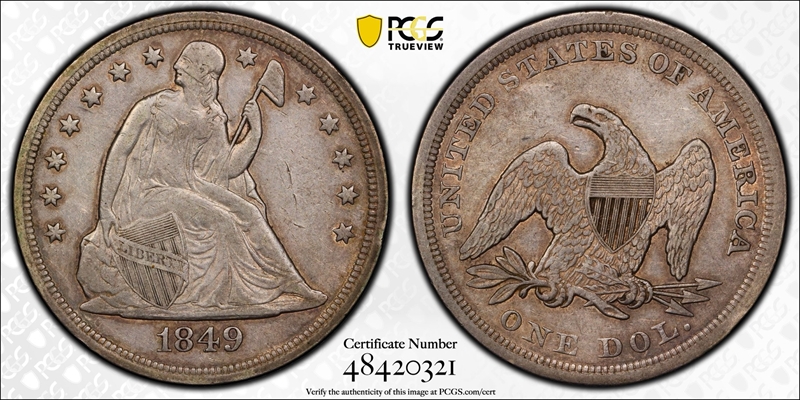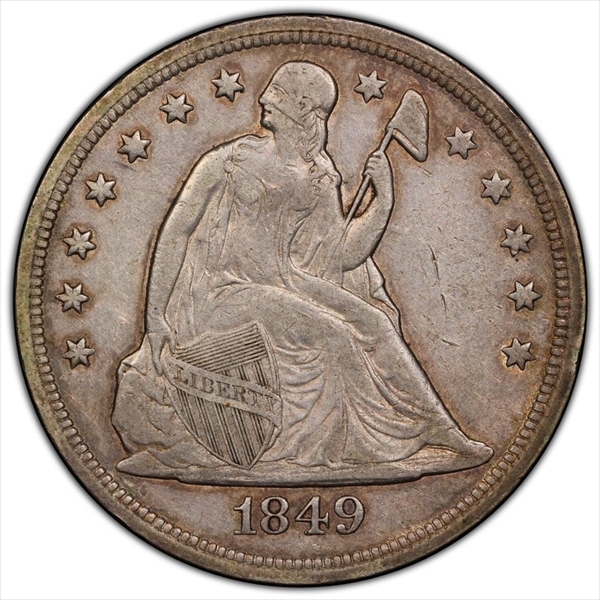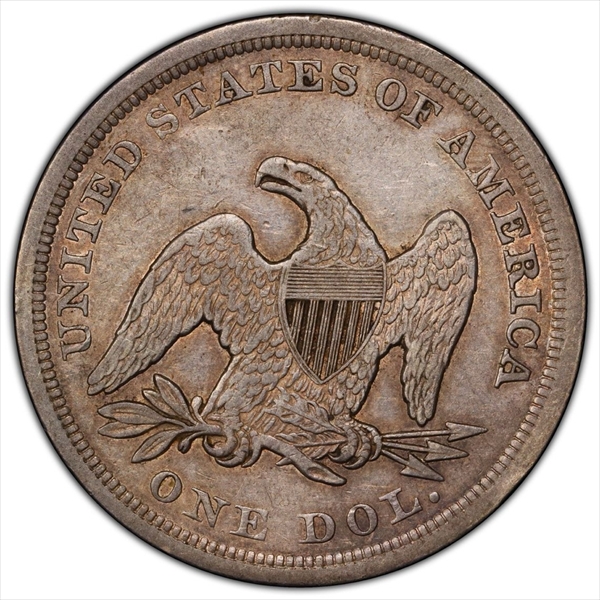1849 $1 XF40 认证号48420321, PCGS号6936
专家评论
Ron Guth
Like most of the Seated Liberty Dollar dates in the 1840's, the 1849 is semi-scarce in all grades and tough in Mint State. Compared to the overall populations of the era, the 1849 is comparable in rarity to the 1840 and 1841, but it is not as rare as the 1844 and 1845, nor is it anywhere near as common as the 1842, 1843, 1846, and 1847. In Mint State, the 1849 is known by at least 75,and possibly 100, different examples, most of which are MS61 to MS64. Gems are exceedingly rare, but the 1849 is graced with one truly remarkable PCGS MS67 example, making it one of only two dates in the series with a coin in that grade.
Q. David Bowers
The following narrative, with minor editing, is from my "Silver Dollars & Trade Dollars of the United States: A Complete Encyclopedia" (Wolfeboro, NH: Bowers and Merena Galleries, Inc., 1993).Coinage Context
Circulating issue: The year 1849 is the last in which Liberty Seated silver dollars were made in quantity at the Philadelphia Mint and also the last in which virtually the entire production was placed into circulation at the time. However, there are different opinions in the historical record, and it may be the case that large numbers of dollars of this date were exported (see citation on this subject under Coinage Context, 1848).
Gold vs. silver (once again): Gold! Gold! Gold! Newspapers of 1849 carried little other national news. As metal was extracted from placers (streams and loose soil) and mines, gold began to become common on world markets, and the ratio of the value of gold to silver began to slide from the statutory 16 to 1, to 15.45 to 1 early in 1851. As this trend continued, silver coins were withdrawn from circulation, hoarded and exported. Many were later melted as they were worth more than face value as bullion.
In 1849 Congress authorized the production of two new denominations, the $20 gold (officially, double eagle) and the diminutive gold dollar. Gold dollars were minted in quantity during the year, but no $20 pieces were made for circulation until 1850.
It was expected that gold dollars, made in large numbers, would help fill in when silver coins were in short supply (this demand dropped after 1853 when silver coins once more became available in the marketplace). From this point, the silver dollar became a whipping boy for certain Mint officials, who began to call for its discontinuation. It was not logical, they stated, to have two metal dollars, one (silver) worth more than the other (gold).
Numismatic Information
Circulated grades: Although this date has approximately the same mintage as the 1840, circulated examples are seen on the market more frequently.
Mint State grades: The 1849 silver dollar is quite elusive in Mint State. I have handled very few of this date over the years. I suspect that it may be somewhat rarer than the numbers I give below in the Summary of Characteristics, although the population data from certification services do not reflect this. At least one person who reviewed this manuscript considered the 1849 to be among the easier dates of the 1840s to find in Mint State grade. However, in 1982, Bruce Amspacher stated that he knew of only three specimens that could be called MS-65, a grade that today would be equal to MS-63 or so. One of these coins, appearing in February 1978 in the Bowers and Ruddy Galleries auction of the Fairfield Collection, was by June 1992 graded MS-66 by PCGS.(Article, "Liberty Seated Dollars," in the Monthly Summary, Coin Dealer Newsletter, July-August, 1982. Also, notes from Bruce Amspacher to the author, received in June 1992.) Chris Napolitano commented as follows: (Letter to the author, June 26, 1992.) "Very tough in MS-63 or better. This date is underpriced in Coin World 'Trends,' and Mint State coins are very difficult to locate."
Often several people describing a numismatic situation reminds one of the old verses about the six blind men describing an elephant. One felt the tail and said the elephant was like a rope. Another, who touched the trunk, said the beast was like a hose. Another, touching a leg, believed it was like a tree, while still another blind man, feeling the elephant's side, thought the animal was like a wall. Similarly, opinions concerning the availability of a given coin, such as a Liberty Seated dollar in Mint State, are apt to vary from one person to another. Earlier, I cited a study which suggested that Mint State 1845 dollars were common, while I consider them to be rare, etc.
Varieties
Circulation strikes:
1. Normal Date: Breen-5441. Circulation strikes have not been studied in detail. Some early impressions have "chin whiskers," or die file marks extending below the chin, a feature also seen on certain other dates, notably 1853. A few have the reverse die rotated 15° to the right of normal alignment.
Dies prepared: Obverse: Unknown; Reverse: Unknown
Circulation strike mintage: 62,600; Delivery figures by month: January: 17,000; March: 14,000; May: 11,000; August: 2,000; October: 9,000; December: 9,600.
Estimated quantity melted: Unknown
Characteristics of striking: Striking varies; some are well struck and others show local weakness (particularly at the eagle's neck immediately above the shield and at the eagle's dexter leg and/or at the stars on the right obverse). Some circulation strikes, even those with areas of light striking, have knife-rims, partial on the obverse, nearly full on the reverse, and prooflike surface on both sides.
Known hoards of Mint State coins: None
Commentary
Although this issue is readily available in worn grades, in Mint State it is very rare.
Additional Information
The Mint in 1849
At the Mint in 1849, the usual speed of striking coins was as follows: for silver dollars and half dollars, 60 pieces per minute; 75 per minute for the quarter dollar; 90 for the dime and half dime. (Information from The Bankers' Magazine, collected volume June 1848 through June 1849, p. 556.)
The Mint had about 50 employees. It was calculated that if the Mint were to operate at its maximum capacity and to coin 12 million dollars annually, half in gold and half in silver, with a standard proportion of distribution throughout the denominations, then it cost the government $106,000 to do this. More employees would be needed, however.
PCGS #
6936
设计师
Christian Gobrecht
边缘
Reeded
直径
38.10 毫米
重量
26.73 克
铸币数量
62600
金属成分
90% Silver, 10% Copper
更高评级数量
385
评级较低的钱币数量
79
地区
The United States of America
价格指南
PCGS 数量报告
拍卖 - PCGS 评级的
拍卖 - NGC 评级的
稀有性和存量估计 了解更多
| 所有评级 | 2600 |
| 60或以上 | 100 |
| 65或以上 | 2 |
| 所有评级 | R-4.4 |
| 60或以上 | R-8.0 |
| 65或以上 | R-9.9 |
| 所有评级 | 24 / 30 |
| 60或以上 | 19 / 30 TIE |
| 65或以上 | 7 / 30 TIE |
| 所有评级 | 37 / 45 TIE |
| 60或以上 | 28 / 45 TIE |
| 65或以上 | 8 / 45 TIE |


























